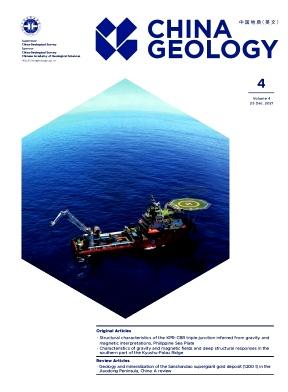Geochronology, petrogenesis, and tectonic characteristics of a volcanic–intrusive complex on the northern margin of North China Craton and its limitation on the closing time of the Paleo-Asian Ocean (245 Ma)
IF 4.7
3区 地球科学
Q1 GEOSCIENCES, MULTIDISCIPLINARY
引用次数: 0
Abstract
The Central Asian Orogenic Belt (CAOB) is one of the largest and best preserved accretionary type orogenic belts in the world. Due to its complex tectonic history, the timing and location of the final closure of the Paleo-Asian Ocean and its tectonic evolution have been hotly discussed. To determine the petrogenesis and tectonic characteristics of the poorly exposed Triassic volcanic-intrusive complex on the northern margin of the eastern North China Craton, the authors conducted a study of zircon Lu-Hf isotopes, integrated with zircon U-Pb dating and whole-rock geochemistry. Zircons from eight representative volcanic and intrusive samples yielded concordant U-Pb ages of 251–245 Ma. The volcanic and intrusive rocks are all characterized by enrichments in large ion lithophile elements and depletions in high field strength elements, and they have features similar to those of highly fractionated I-type granites. The εHf(t) values for the volcanic and intrusive rocks, respectively, range from –1.69 to +3.75 (mean=+1.22) and –2.17 to +3.15 (mean=+0.38), with two-stage model ages of 1035–1345 Ma (mean=1196 Ma) and 1073–1401 Ma (mean=1250 Ma). The Hf isotopic features indicate that these rocks were formed by partial melting of young crustal material that was newly accreted from the depleted mantle, together with a degree of contamination by other crustal material. The volcanic–intrusive complex was related to an active continental margin in a volcanic arc and syn-collisional setting, indicating that the Paleo-Asian Ocean was closed after the Middle Triassic (245 Ma) along the northern margin of the North China Craton. This provides a constraint on the timing of the change in tectonic setting in this area from compression to extension. The results enhance our understanding of the evolution of the Paleo-Asian Ocean.
华北克拉通北缘火山-侵入杂岩年代学、岩石成因及构造特征及其对古亚洲洋闭合时间(245 Ma)的限制
中亚造山带是世界上规模最大、保存最完好的增生型造山带之一。由于其复杂的构造历史,古亚洲洋最终闭合的时间和位置及其构造演化一直是人们讨论的热点。为了确定华北克拉通东部北缘三叠纪火山-侵入杂岩的岩石成因和构造特征,结合锆石U-Pb定年和全岩地球化学研究,对其进行了锆石Lu-Hf同位素研究。8个具有代表性的火山和侵入样品的锆石U-Pb年龄在251 ~ 245 Ma之间。火山岩和侵入岩均以大离子亲石元素富集、高场强元素亏缺为特征,具有与高分选i型花岗岩相似的特征。火山岩和侵入岩的εHf(t)值分别为-1.69 ~ +3.75(平均值=+1.22)和-2.17 ~ +3.15(平均值=+0.38),两阶段模型年龄分别为1035 ~ 1345 Ma(平均值=1196 Ma)和1073 ~ 1401 Ma(平均值=1250 Ma)。Hf同位素特征表明,这些岩石是由从枯竭的地幔中新增加的年轻地壳物质的部分熔融以及其他地壳物质的一定程度的污染形成的。该火山-侵入杂岩体与火山弧和同碰撞环境下的活动大陆边缘有关,表明中三叠世(245 Ma)以后,古亚洲洋沿华北克拉通北缘闭合。这为该区构造环境由挤压向伸展转变的时间提供了约束。这些结果增强了我们对古亚洲海洋演化的理解。
本文章由计算机程序翻译,如有差异,请以英文原文为准。
求助全文
约1分钟内获得全文
求助全文

 求助内容:
求助内容: 应助结果提醒方式:
应助结果提醒方式:


